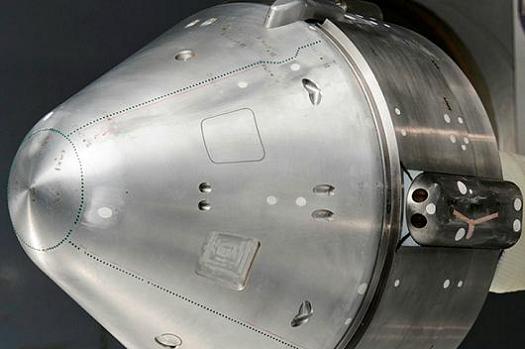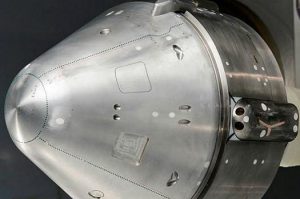

A model of Boeing’s CST-100 spacecraft, equipped for wind tunnel tests at NASA Ames Research Center – (Credits: Boeing).
Source Edward Memi, Boeing: Boeing is nearing completion of wind-tunnel testing for a new spacecraft to ferry people and cargo to the International Space Station. Engineers have been testing the spacecraft, called the Crew Space Transportation (CST)-100, since Sept. 17 at NASA’s Ames Research Center in California. The test team is using a 12-inch-wide, 14-inch-long aluminum model that is about 1/14th the size of the operational space capsule that Boeing plans to build. Testing is scheduled to conclude by the end of October. Using hundreds of pinhole-sized sensors, the wind-tunnel tests measure how air flows across the model. Boeing engineers plan to test the model in more than 20 different positions to mimic the different phases of an aborted landing.
“As engineers, we like data and numbers, and you can take all of this and make something meaningful out of it,” said Boeing engineer Dustin Choe. “We can reduce it down and provide a clearer picture of what we will experience in flight.” The wind-tunnel tests help ensure the spacecraft is structurally sound and can be controlled safely. Engineers will tweak CST-100’s design based on the data collected. The wind-tunnel activity is part of a series of planned tests for CST-100. Boeing and teammate Bigelow Aerospace recently dropped a mock capsule off a moving truck to test the external airbags the real spacecraft would deploy to cushion a landing on Earth.
CST-100 will transport up to seven people or a mix of people and cargo to low-Earth-orbit destinations, such as the International Space Station and Bigelow Aerospace’s planned space station. Boeing is one of four companies competing under NASA’s Commercial Crew Development program to develop crew vehicles to restore the United States’ capability to provide access to the International Space Station by 2016.
Originally published by Boeing on October 10, 2011.

















































































































![A trajectory analysis that used a computational fluid dynamics approach to determine the likely position and velocity histories of the foam (Credits: NASA Ref [1] p61).](http://www.spacesafetymagazine.com/wp-content/uploads/2014/05/fluid-dynamics-trajectory-analysis-50x50.jpg)



Leave a Reply